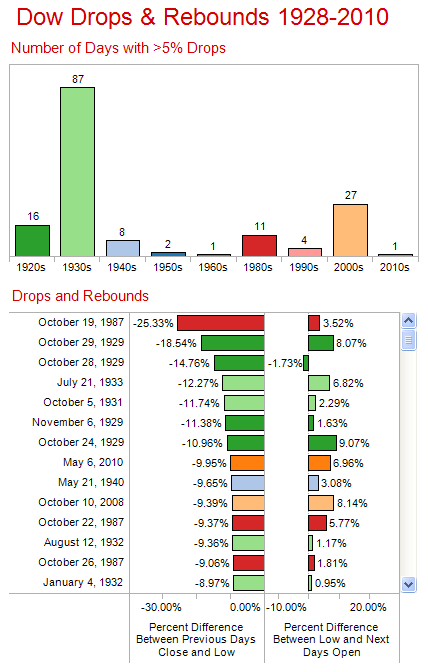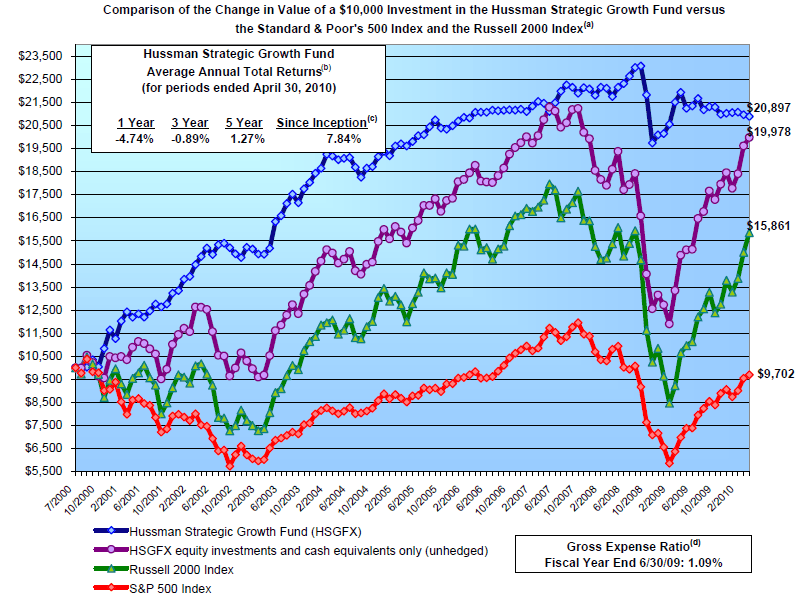Summary: Crashes are a normal consequence of extremely overbought and overpriced markets, and huge rallies like Monday’s are almost the exclusive providence of bear markets. Crashes and giant rallies are both characteristic of times of credit stress.
First, let John Stewart explain (if like me you’re not in the US, try this trick to watch restricted videos) :
-
Now on to Hussman. The below is taken from his latest market comment. You could also say that Hussman “called” this decline, since starting several weeks prior to the peak (see archive) he characterized the market as “overvalued, overbought, and overbullish” and hedged up his stock mutual fund with put options and short call positions. I have followed him for some time, and he is as good a market timer as I know*; you don’t want to be long stocks when he’s fully hedged!
Of all the mysteries of the stock exchange there is none so impenetrable as why there should be a buyer for everyone who seeks to sell. October 24, 1929 showed that what is mysterious is not inevitable. Often there were no buyers, and only after wide vertical declines could anyone be induced to bid … Repeatedly and in many issues there was a plethora of selling orders and no buyers at all. The stock of White Sewing Machine Company, which had reached a high of 48 in the months preceding, had closed at 11 on the night before. During the day someone had the happy idea of entering a bid for a block of stock at a dollar a share. In the absence of any other bid he got it.”
John Kenneth Galbraith, 1955, The Great Crash
“I started accumulating stocks in December of ’74 and January of ’75. One stock that I wanted to buy was General Cinema, which was selling at a low of 10. On a whim I told my broker to put in an order for 500 GCN at 5. My broker said, ‘Look, Dick, the price is 10, you’re putting in a crazy bid.’ I said ‘Try it.’ Evidently, some frightened investor put in an order to ‘sell GCN at the market’ and my bid was the only bid. I got the stock at 5.”
Richard Russell, 1999, Dow Theory Letters
…If the decline we’ve seen to date is the entire resolution of the recent overvalued, overbought, overbullish, rising-yields syndrome, investors will be fortunate. Given that last week’s decline was just enough to clear the “overbought” component of this condition at least on short-term basis, we lowered our S&P 500 put strikes closer to current market levels and “re-set” our staggered strike hedge in the Strategic Growth Fund enough to put us in a more constructive position if the market advances more than a few percent, while maintaining a strong defense against a further market loss. Our overall position is much like a fully hedged stance with a couple of percent of assets in out-of-the-money index calls. We’re in no hurry to “buy the dip.” We don’t rule out much larger, and possibly profoundly larger market losses, but again, last week gave us a nice opportunity to re-set our strikes in a way that allows us to be comfortable in the event that the market recovers.
Thursday was a fascinating day in the market, featuring a 20-minute span in which the Dow moved from a loss of about 300 points to a loss of nearly 1000 points and then back again within a span of about 15-20 minutes. While the decline and recovery was interesting, the fascinating part was the eagerness of investors to view the decline as a “glitch” in trading. My hope is that the opening quotations in this weekly comment are sufficient reminders that illiquidity is not a “glitch,” but a typical feature of panicked markets. In a market where active market makers have increasingly been replaced by “high frequency” trading algorithms that can be switched off at will, it is important for investors to avoid the assumption that there will be a willing buyer close at hand if risk concerns begin to escalate.
If you spend a good portion of your time studying price-volume behavior, “air pockets” of the type we observed last week become familiar parts of the landscape (though they are typically not so distilled into a single intra-day move). Robust demand is the only thing that holds prices from falling vertically in the face of eager selling. Overvalued, overbought, overbullish markets are often already spent of that demand. As investors suddenly became aware of that reality on Thursday, all I could think was “welcome to my world.”
…I think the best way to characterize the market here is to view the area between 1080 and about 1130 on the S&P 500 as something of an “inflection point.” A clear decline below about 1080 on the S&P 500 would most likely put market internals in a clearly negative position, leaving the market with a coupling of overvaluation and negative market internals that has historically been very hostile. We’re not yet to that point, however, so it’s reasonable to allow for the potential for a recovery from these levels while still maintaining a tight hedge against further weakness.
I made many of the same points prior to the mini-crash (, noting the likely record extreme in bullish complacency in the equity put:call ratio, as well as extreme overvaluation and mutual fund cash levels matching the 2007 peak.
After the crash last Thursday I noted that these things just happen. They are one of the risks of the stock market, and are as old as floor trading:
The fact is, markets just fall out of bed sometimes. It’s normal, and they don’t need the kind of reasons you can read about in the paper. Greece had nothing to do with it.
A move like this off a top does not mark the end. If we had plunged hard and reversed like this after we were already reading oversold on sentiment and momentum gauges, it could mark a bottom, but not right off the top — that is what should scare people today. This was not like Black Monday ‘87 — it’s more like the Black Thursdays of ‘29 and ‘08 (huge intraday crashes with recoveries, followed the next week by the real crashes), or the Friday before the ‘87 crash (down 5%). It’s likely a kickoff to more downside. New highs are possible, but looking less and less likely, and we doomsayers might be right after all these months…
You can’t predict a crash, but you can tell probabilities, and the probability of a decline was high as of last week. We had an extremely, extremely depressed put:call ratio, momentum was rolling over, mutual funds were all-in, and just about every measure of sentiment showed that complacency and bullishness were off the charts.
Also the day after the crash I said not to blame the computers and not to reverse those trades:
I didn’t mention anything about computers here, which any discussion of yesterday should have. So yes, computer stop-loss orders kicked in and buy orders were pulled, but this is just what would happen with humans. Every market in the world has experienced some kind of crash this week. It’s not the machines – they basically just do what people do, but faster.
However, you can probably blame computers if you got screwed out of something during a split-second 50-99% drop — that would probably be less likely to happen in a market with human specialists to absorb order flow with their brokerage’s books. But that’s not the cause of the crash, just something that happens during a crash — buyers pull out and stop-losses kick in. In ‘29 you also had solid companies selling for a buck for a few trades. That’s just the way the cookie crumbles, and one of the myriad risks of the equity market.
(BTW, breaking those trades was likely a bad decision on the part of the exchanges. If they had let them sit, those kinds of ridiculous plunges to a penny would be less likely to happen again, as everyone today would be coding away to program their bots to snap up “bargains” during the next swoon. If they could just turn around and cancel the trades, who’s going to take that risk, since you might end up short a stock trading at $20 the next day that you’d bought for $10 and sold for $15? Doesn’t anyone believe in markets anymore? Not even people who run the stock markets? Just let them be, and participants will naturally seize opportunities and add efficiency to the market.)
The cause of this crash is just an overbought, overbullish, overvalued market during a depression (9.9% headline unemployment again, 17% real).
-
-
Mish provided these charts (visit his post to see more data) which help to put the drop into perspective (“largest point drop in history” is meaningless — what counts is the percentage). The data here also shows that huge single-day rallies like Monday’s seem to only happen in bear markets, (as I pointed out on Day 2 of this blog back in August 2008 before the crash):

-
*By the way, here’s the 10-year record of Hussman’s equity mutual fund (top blue line), which, as I understand it, is contractually obligated to be near fully invested in stocks at all times, though it may hedge 100% of its long exposure but not go net short:

